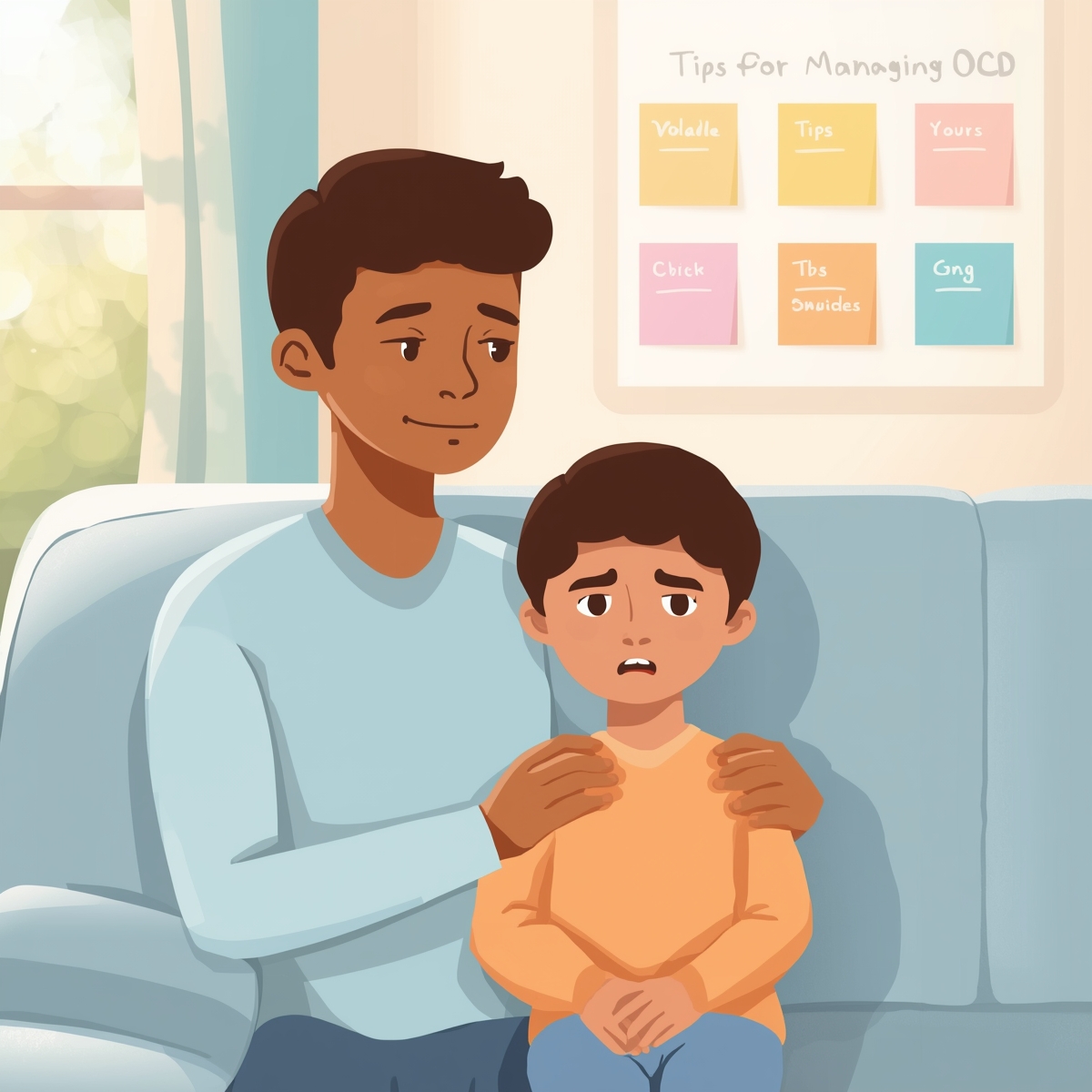Prevention of Childhood OCD Obsessive-Compulsive Disorder (OCD) is a mental health condition that involves persistent, intrusive thoughts (obsessions) and repetitive behaviours (compulsions) performed to ease anxiety. These behaviours, although intended to reduce stress, often interfere with daily life. OCD can develop at any age, and early signs sometimes appear in childhood. Understanding and addressing these signs in the early years can prevent the condition from becoming more severe.
Prevention of Childhood OCD: What It Is and How It Manifests
Prevention of childhood OCD focuses on identifying early symptoms that often appear between the ages of 11 to 16. It is characterized by distressing, repetitive thoughts and compulsive actions that interfere with daily activities, school, and relationships. Unlike typical childhood habits or preferences, OCD behaviours are driven by intense anxiety and the belief that something bad will happen if rituals are not performed.
Symptoms of Childhood OCD
- Excessive handwashing, fear of dirt, or avoiding contact with surfaces
- Repeating actions, such as touching objects a certain number of times
- Needing things to be arranged in a specific order or symmetrical pattern
- Repeatedly seeking reassurance from parents or teachers
- Checking doors, schoolwork, or belongings excessively
- Avoiding certain places or activities due to irrational fears
- Intrusive and distressing thoughts about harm, mistakes, or negative consequences
Without early intervention, OCD can worsen and significantly impact a child’s mental and emotional well-being. However, with the right guidance, children can learn healthy coping strategies and prevent the problem from escalating.
Types of Childhood OCD
- Contamination OCD – Fear of germs, dirt, or illness, leading to excessive washing, cleaning, or avoiding certain places and people.
- Checking OCD – The need to repeatedly check doors, locks, homework, or other items to prevent imagined disasters.
- Symmetry and Order OCD – A strong need for things to be arranged perfectly or symmetrically, leading to distress if disrupted.
- Harm OCD – Intense fear of causing harm to oneself or others, even if there is no real intention or risk.
- Intrusive Thoughts OCD – Unwanted, distressing thoughts about inappropriate or scary subjects that the child feels unable to control.
- Counting and Repeating OCD – The compulsion to count, repeat words, or perform actions a specific number of times to feel safe or prevent bad things from happening.
- Hoarding OCD – Difficulty discarding items due to fear of losing something important, even if the objects have little value.
Prevention of OCD in Early Childhood
While some risk factors for OCD exist, parents and caregivers can take proactive steps to prevent OCD and ensure children develop healthy coping mechanisms.
1. Develop Resilience in Children
Resilience means bouncing back and adjusting when facing difficulties. Parents can foster resilience by encouraging problem-solving, teaching stress management, and creating supportive environments where mistakes are learning opportunities.
2. Provide Opportunities for Exposure
Encouraging children to face fears in a supportive way helps prevent anxiety-driven behaviours. Gradual exposure builds confidence and teaches that uncertainty is manageable.
3. Teach Emotional Independence
Children should learn to seek guidance without being overly influenced by negative opinions. Teaching critical thinking and self-reflection helps them develop balanced perspectives.
4. Instil a Strong Work Ethic
“Work is worship.” Focusing on meaningful activities prevents overthinking and builds a sense of purpose.
5. Encourage Age-Appropriate Actions
A balanced approach to responsibilities helps children grow without unnecessary pressure or boredom.
6. Celebrate Life and Embrace Experiences
Teaching children that challenges are a natural part of life helps them develop adaptability and resilience.
7. Express and Understand Emotions Wisely
Helping children recognize and process their emotions prevents suppression that may later manifest as obsessions or compulsions.
8. Encourage Action Over Excessive Thinking
Practical actions reduce worry. Set small goals and reward efforts.
9. Handle Criticism in a Healthy Manner
Teaching children to view criticism constructively builds confidence and reduces fear of mistakes.
10. Accept Uncertainty as a Part of Life
Model and encourage flexibility to help children tolerate unpredictability.
11. Focus on Completion Over Perfection
Encouraging task completion builds confidence and reduces stress from unrealistic standards.
12. Learn from Failure and Move Forward
Reframing failures as learning opportunities reduces fear and perfectionism.
13. Appreciate What You Have
Practising gratitude helps reduce anxiety and promotes positivity.
14. Build Confidence Through Small Steps
Small achievements strengthen coping abilities over time.
15. Persistence Leads to Success
Encouraging persistence helps children overcome helplessness and obsessive tendencies.
16. Apply Knowledge Constructively
Practical application of knowledge builds purpose and problem-solving skills.
17. Set Meaningful and Inspiring Goals
Realistic goals motivate children and reduce worry about trivial issues.
Frequently Asked Questions on Prevention of Childhood OCD
Q1. Can OCD be prevented in children? A: While OCD cannot always be completely prevented, early awareness, emotional support, and professional intervention can stop mild symptoms from becoming severe. Q2. What are the early warning signs of OCD in children? A: Repetitive behaviors (washing, checking, arranging), excessive doubts, intrusive thoughts, fear of contamination, or needing things to be “just right.” Q3. How can parents help in preventing OCD from worsening? A: By recognizing early signs, avoiding criticism, providing reassurance, and seeking timely therapy, parents can significantly reduce the risk of OCD escalating. Q4. Can lifestyle and environment influence OCD in children? A: Yes. Stressful environments, high expectations, or lack of emotional support can worsen OCD tendencies. A calm, supportive atmosphere helps prevention. Q5. Why choose Emotion of Life for prevention of childhood OCD? A: Emotion of Life, led by Shyam Gupta & Pratibha Gupta, specializes in early intervention programs blending CBT, ERP, and parental guidance to protect children from long-term OCD struggles.
Success Stories of Overcoming Childhood OCD (Emotion of Life)
Success Story 1 – Aarav’s Early Intervention
Aarav, a 10-year-old boy, constantly washed his hands and feared contamination. His parents brought him to Emotion of Life early, where Shyam Gupta used gentle ERP exercises and parental coaching. Within 12 weeks, Aarav reduced his handwashing by 70% and became more confident in school.
“Catching it early saved our son from years of struggle. Emotion of Life gave Aarav a happy childhood back.”
Success Story 2 – Meera’s Journey
Meera, age 12, developed compulsions of checking her school bag repeatedly. At Emotion of Life, Pratibha Gupta guided her through mindfulness, CBT, and family counseling. Within 4 months, Meera overcame her checking rituals and regained focus on studies.
“Thanks to early help from Emotion of Life, Meera is free from the cycle of OCD.”
16 Steps of OCD Recovery & Cure Program (Adapted for Prevention in Kids)
- Comprehensive Assessment – Identifying early OCD symptoms in children.
- Personalized Recovery Roadmap – Child-focused therapy plan.
- Psychoeducation for Parents & Child – Understanding OCD and myths.
- Identifying Triggers – Spotting patterns that start compulsions.
- Thought–Behavior Mapping – Linking obsessions with rituals.
- Exposure & Response Prevention (ERP) – Gentle exercises for children.
- Cognitive Restructuring (CBT) – Helping child reframe fearful thoughts.
- Mindfulness & Relaxation Skills – Age-appropriate calming tools.
- Habit Reversal Training – Replacing compulsions with healthy actions.
- Parental Coaching – Training parents to support recovery.
- Stress & Lifestyle Balance – Sleep hygiene, nutrition, routines.
- Emotional Resilience Training – Building confidence and self-esteem.
- Progress Tracking – Weekly sessions with child and parents.
- Family Therapy Sessions – Aligning family response to OCD.
- Relapse Prevention Tools – Preparing for future challenges.
- Celebrating Recovery – Reinforcing success and long-term well-being.
Conclusion on Prevention of Childhood OCD
Prevention of childhood OCD is about fostering a healthy, resilient, and flexible mindset. By encouraging children to embrace uncertainty, focus on progress over perfection, and build confidence through real-life experiences, parents and caregivers can help them develop strong mental habits that will serve them throughout life.
Early identification of OCD symptoms and supportive parenting can make a significant difference in a child’s ability to manage stress and avoid developing obsessive-compulsive behaviours. With the right guidance, children can grow into emotionally balanced individuals, capable of handling challenges without falling into obsessive or compulsive patterns.
Call now: +91 9368503416
Website: www.emotionoflife.in
Email: info@emotionoflife.inOCD Types | Meet Our Experts | Success Stories | Contact Us










